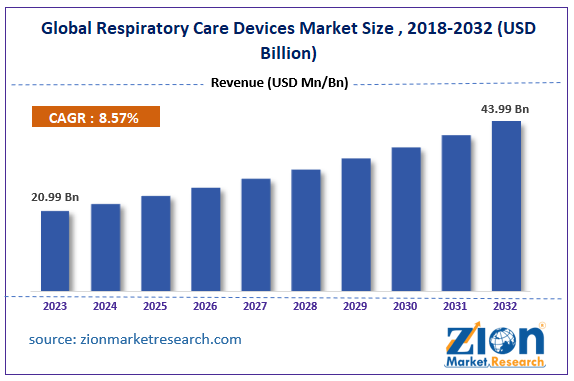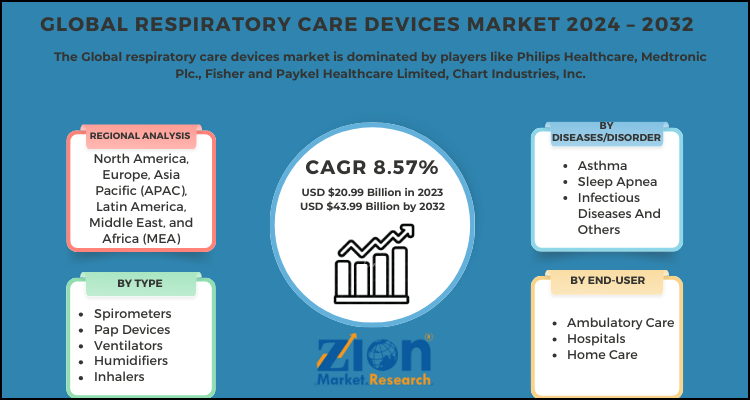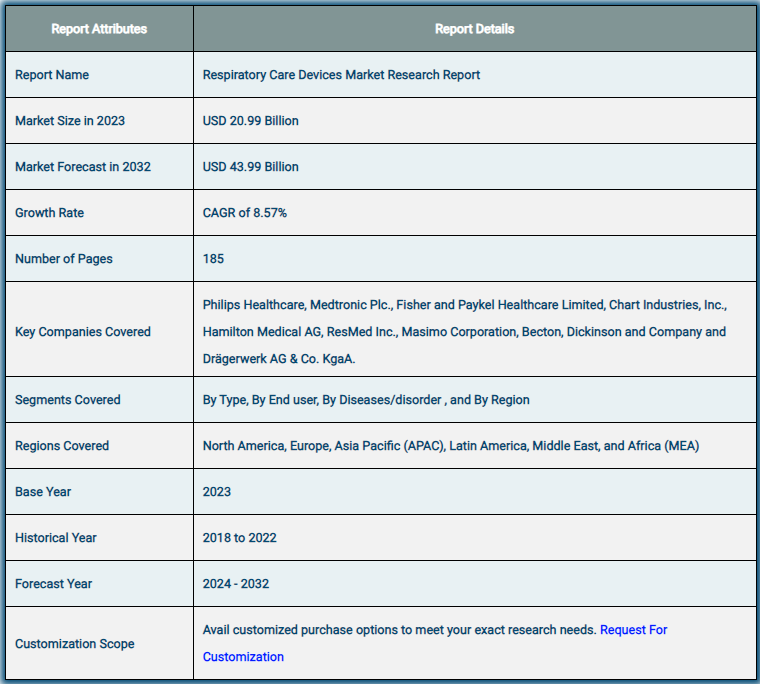Respiratory Care Devices Market Size, Share, Growth Report 2032

✈👉Get a Free Sample: 🚀https://www.zionmarketresearch.com/sample/respiratory-care-devices-market
Introduction:
- Overview of Respiratory Care Devices:
Introduce respiratory care devices as essential medical tools used to manage respiratory disorders, such as asthma, chronic obstructive pulmonary disease (COPD), and other conditions affecting breathing. - Importance of the Market:
Highlight the critical role of respiratory care devices in improving patient outcomes, enhancing quality of life, and reducing healthcare costs associated with respiratory diseases.
Overview of the Global Respiratory Care Devices Market
Medical devices used for therapy, control, assessment, management, diagnosis, and patient care that include abnormalities in the cardiopulmonary system include respiratory care equipment. Asthma, acute and chronic respiratory disorders, and degenerative lung illnesses including emphysema and chronic bronchitis are treated using these devices. The rise in chronic obstructive pulmonary disorders (COPD) is driving significant market growth. Both homecare and hospital settings use the respiratory care devices. The respiratory equipment is now portable rather than stationary. The utilisation of portable gadgets has increased.

Market segmentation for respiratory care devices worldwide
Global market segmentation for respiratory care devices is based on product type, end user, disease/disorder, and geography.
The market is divided into four categories based on device type: therapeutic, diagnostic, monitoring, and consumables and accessories.
The therapeutic devices are further divided into oxygen concentrators, masks, nebulisers, ventilators, humidifiers, inhalers, nitric oxide delivery systems, PAP devices, and oxygen hoods.
The monitoring devices section is further divided into capnographs, gas analysers, and pulse oximeters.
Spirometers, peak flow meters, polysomnography devices, peak flow meters, and other devices are subclassified under the diagnostic devices section.
The following other categories are included in the consumables and accessories segment: disposable resuscitators, tracheostomy tubes, disposable masks, and others.
The respiratory care equipment market is divided into categories based on ailments, including infectious diseases, asthma, sleep apnoea, and chronic obstructive pulmonary disease (COPD).
Hospitals, home care, and ambulatory care are the many end users that make up the respiratory care devices industry.
The market is divided geographically into North America, Europe, Asia-Pacific, and the Rest of the World.

Growth Factors for the Global Respiratory Care Device Market
The rise in the number of patients with chronic pulmonary obstructive diseases, changes in the environment and lifestyle, the introduction of new products with a robust pipeline, rapid urbanisation, and an ageing population are the main factors propelling the global respiratory care devices market. In the home care sector, there is a high need for respiratory care devices. Furthermore, the market’s expansion has been supported by the government’s supportive policies. The hazards associated with therapeutic devices for neonates, customer ignorance, and the excise tax imposed on the devices are some of the factors impeding the growth of the industry.
✈👉Directly Purchase a copy of the report with TOC: 🚀https://www.zionmarketresearch.com/toc/respiratory-care-devices-market
Market Analysis of Respiratory Care Devices: Report Scope

Regional Analysis of the Global Respiratory Care Devices Market
North America and Europe are the two largest regions in the world market for respiratory care equipment. The vast number of people with respiratory diseases brought on by tobacco use and other lifestyle choices, the highly developed health care system, and the availability of skilled workers to operate cutting-edge respiratory equipment are some of the causes driving this increase. Significant growth is also occurring in the Asia Pacific region. The market is growing because of things like the expanding infrastructure for health care and rising disposable income.
Market Drivers:
- Increasing Prevalence of Respiratory Diseases:
The rising incidence of respiratory conditions, particularly among the aging population and individuals exposed to environmental pollutants, is driving demand for respiratory care devices. - Technological Advancements:
Innovations in respiratory care technologies, such as portable and home-based devices, are enhancing patient monitoring, diagnosis, and treatment options. - Growing Awareness of Respiratory Health:
Increased awareness regarding the importance of respiratory health and early diagnosis is propelling demand for respiratory care devices. - Rising Healthcare Expenditure:
Growing healthcare spending, particularly in developing regions, is facilitating access to advanced respiratory care technologies.
Market Restraints:
- High Cost of Advanced Devices:
The significant capital investment required for high-end respiratory care devices can be a barrier for smaller healthcare facilities. - Regulatory Challenges:
Navigating complex regulatory pathways for the approval and certification of respiratory devices can hinder market growth. - Shortage of Skilled Healthcare Professionals:
A lack of trained professionals to operate advanced respiratory care devices and interpret results may limit their effective utilization.
Market Segmentation:
- By Device Type:
- Therapeutic Devices:
- Ventilators: Devices used to provide mechanical ventilation to patients who are unable to breathe adequately.
- Nebulizers: Devices that convert liquid medication into mist for inhalation.
- Continuous Positive Airway Pressure (CPAP) Devices: Used for treating obstructive sleep apnea.
- Monitoring Devices:
- Pulse Oximeters: Used to measure blood oxygen levels.
- Capnometers: Used to measure carbon dioxide levels in exhaled air.
- By Application:
- Chronic Obstructive Pulmonary Disease (COPD): The largest application segment, focusing on managing and treating COPD.
- Asthma: Devices used for managing asthma symptoms and preventing attacks.
- Sleep Apnea: Devices specifically designed for diagnosing and treating sleep apnea.
- By End-User:
- Hospitals: The largest end-user segment, requiring respiratory care devices for patient management.
- Home Healthcare: Increasing adoption of respiratory care devices for home use.
- Ambulatory Surgical Centers: Facilities using respiratory care devices in surgical and outpatient settings.
Regional Insights:
- North America:
The largest market for respiratory care devices, driven by a high prevalence of respiratory diseases, advanced healthcare infrastructure, and significant investments in research and development. - Europe:
A significant market characterized by a growing elderly population and increasing healthcare expenditure. Countries like Germany and the U.K. are leading in market growth. - Asia-Pacific:
The fastest-growing region, propelled by rising healthcare investments, increasing awareness of respiratory diseases, and growing patient populations. Countries like China and India are witnessing rapid advancements in respiratory care technologies. - Rest of the World (RoW):
Analyze market dynamics in regions like Latin America, the Middle East, and Africa, where improving healthcare infrastructure is fostering the growth of respiratory care devices.
Competitive Landscape:
- Key Players:
Discuss leading companies in the respiratory care devices market, such as Philips Healthcare, ResMed, Medtronic, and others. Highlight their product offerings, market strategies, and recent developments. - Technological Innovations and Collaborations:
Emphasize recent advancements, product launches, and partnerships that enhance the capabilities of respiratory care devices.
Future Outlook and Trends:
- Integration of Artificial Intelligence:
The incorporation of AI and machine learning in respiratory care devices will enhance patient monitoring, predictive analytics, and personalized treatment plans. - Rise of Telehealth and Remote Monitoring:
The growing trend towards telehealth will facilitate remote monitoring of respiratory conditions, improving patient engagement and care management. - Focus on Home Healthcare Solutions:
Increasing demand for home healthcare solutions will drive the development of user-friendly and portable respiratory care devices. - Sustainability and Eco-Friendly Products:
Growing environmental awareness may lead manufacturers to develop more sustainable and eco-friendly respiratory care devices.
Conclusion:
Summarize the key trends and growth opportunities in the respiratory care devices market, emphasizing drivers such as technological advancements, increasing prevalence of respiratory diseases, and rising healthcare expenditure. Highlight the potential for growth in emerging markets and the importance of addressing challenges related to costs and skill shortages.
✈👉Enquiry for buying: 🚀https://www.zionmarketresearch.com/inquiry/respiratory-care-devices-market
Browse other trend reports:
Contact Us:
Zion Market Research212
USA/Canada Toll Free: 1 (855) 465–4651
Newark: 1 (302) 444–016611\
Web: https://www.zionmarketresearch.com/
Blog: https://zmrblog.com/
Comments
Post a Comment